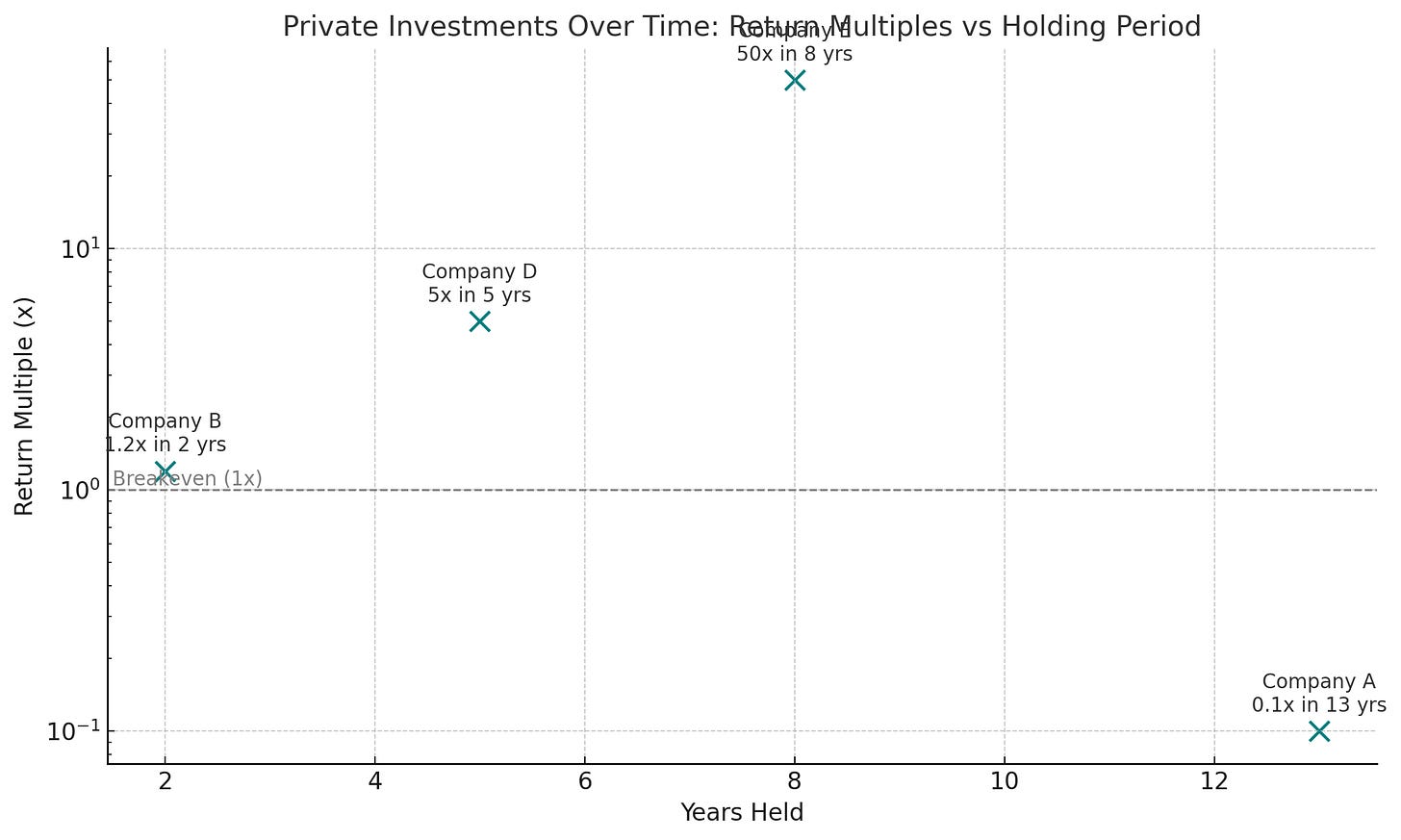Skin in the Game
Employee stock options & Asymmetric bets
After eight years of a wonderful professional journey, I find myself at the verge of leaving Quantcast, my current employer. As part of this transition, I’ve just exercised all the stock options I accumulated over the years.
Today, I want to talk about that decision — and more broadly, about the nature of asymmetric bets and how they shape the path to long-term wealth building.
What’s an Asymmetric Bet?
In investing, an asymmetric bet is when the potential upside significantly outweighs the potential downside. It’s the kind of opportunity where you're risking a small amount for the possibility of a much larger return.
For instance, if you invest $1 with the chance of making $10, and the worst-case scenario is losing that $1 — that’s an asymmetric bet. Even if the probability of success is low, the payoff (when it hits) can justify a lot of small losses along the way.
Symmetric vs Asymmetric: A Spectrum
Let’s contrast that with more symmetric investments — like buying a blue-chip stock or a diversified index ETF. Over a 3–5 year horizon, you might reasonably expect an annual return of 10%, and perhaps a 30% drawdown in a worst-case market cycle.
Of course, the upside/downside probabilities aren’t equal — we generally expect to make money more often than lose it. That’s why we invest at all. But the structure of return is range-bound — the downside and upside aren’t wildly dissimilar.
You see this in a lot of traditional investments — bonds, rental real estate, defensive stock strategies — where the core idea is preservation of capital and steady compounding. Nothing wrong with that.
But asymmetric bets live at the other end of the spectrum.
Take early-stage startups. You don’t invest $1 in a startup hoping to get $1.10 next year. You do it hoping for a $10 or $100 return — knowing full well that the $1 may never come back at all.
You’re deliberately choosing an investment with a high probability of failure, but a massive payoff in rare success. It’s not for everyone. But when you’re thoughtful about it — and spread those bets with care — the math can work in your favour.
Asymmetry in the Wild
In public markets, true asymmetric bets are hard to find, especially a priori. Most show up only in hindsight. Investors in Tesla, NVIDIA, or early Bitcoin were handsomely rewarded, but it wasn’t obvious (or broadly accepted) at the time.
There are pockets of investing focused purely on asymmetry. Option traders buying out-of-the-money calls. Deep value investors buying net-nets (where the company’s cash and assets already cover the share price, giving you free upside if the business turns around). Or special situations investors with a keen eye for mispriced risk.
The common thread? You limit downside, while leaving upside uncapped.
My Track Record with Private Bets
In public equities, I’ve rarely stumbled onto these kinds of setups. I’ve been on the lookout, and I’ve had a few modest wins — but they’re rare.
Ironically, the best asymmetric bets I’ve ever made have come from my professional life.
Almost every startup I’ve worked for offered equity. Sometimes meaningful. Sometimes symbolic. But always structured around the same core idea: If we succeed, we all share in the upside.
It’s not just incentive alignment. It’s shared risk.
Over the last 15 years, I’ve invested in five private companies I’ve worked closely with. The results:
0.1x return after 13 years
1.2x after 2 years
0x after 3 years
5x after 5 years
50x after 8 years. (Obviously, the x in question was small, else I’d be writing this from a yacht in the Caribbean 😊.)
All my past outcomes were acquisitions, but took varying amounts of time and produced wildly different outcomes. One was a total bust. But when you look at the portfolio, not just the individual stories — it becomes clear why asymmetric bets, when taken selectively, can change your trajectory.
The Psychology of Playing the Long Game
But here's the catch: to benefit from asymmetry, you need a few things.
Prudence — You can’t overbet. Losing 100% is always a possibility.
Patience — These bets take years to play out. Sometimes decades.
Detachment — You need the mindset to invest, forget, and move on with life.
That last one might be the hardest. I’ve learned it the hard way — watching a company I believed in flame out. And also the rewarding way — seeing another quietly deliver life-changing returns years later, after I’d mentally written it off.
Back to Quantcast
So what about Quantcast?
Do I know if this will be a 1x, 5x, 10x or — dare I say — 100x? No. I have no clue.
Do I know if the outcome will materialize in a year, or in five, or never? Again, no idea.
What I do know is this:
I know the team.
I know the technology.
I know the customers, the revenue model, the business dynamics.
I’ve seen the leadership make hard calls. I’ve watched the business navigate tough cycles.
I have more context than most outside investors ever will.
And in balance, I believe this bet offers me a better return profile than many other places I could put my money. It’s not guaranteed. But that’s not the point.
The point is that I’m in a privileged position — one where I can place this bet, ride out the uncertainty, and absorb the outcome — whatever it may be. That, I think, is my edge.
So I jumped in. I exercised the options. I made the bet.
Let’s see where it goes.
👋 Curious to hear from you
Have you made asymmetric bets in your career or investing life — ones where the payoff took years (or didn’t materialize at all)? How do you think about risk, time, and conviction?
Feel free to reply or leave a comment. I'd love to learn from your experience.
As always, happy investing!
Disclaimer: I am not your financial advisor and bear no fiduciary responsibility. This post is only for educational and entertainment purposes. Do your own due diligence before investing in any securities. I may hold or enter into, a position in any of the stocks mentioned above. The above is NOT a solicitation to either buy or sell the securities listed in this post.




